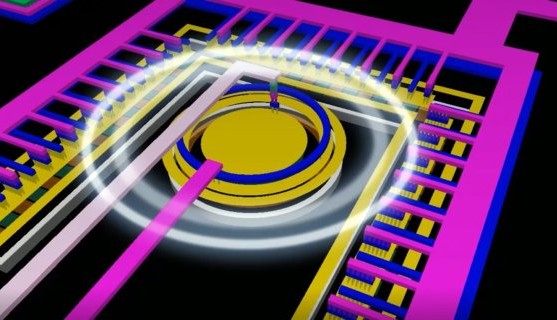Light connects two worlds
on

Researchers from the University of Twente have succeeded in connecting two parts of an electronic chip using an optical link. This is, for example, necessary when one part processes digital signals while the other operates with large powers or voltages: there is preferably no galvanic connection between these two parts. An optical connection is then a solution, but unfortunately this is not that easy to realise.
Galvanic separation
An optical connection realises a galvanic separation on a chip: two very different worlds are able to communicate with each other, but there is no electrical connection between them. In this manner it can, for example, be prevented that the high-power part has undesirable effects on the digital control, on the same chip. Application examples are chips for the automotive industry, medical applications and in smart power-electronics. An optical connection is currently made using an optocoupler. These have up to now been separate and relatively large ICs. The newly developed optocoupler can be integrated into the electronics, does not occupy more than 0.008 mm² and uses very little energy.
Connecting the wrong way around
Integrating a light source with the electronics in the chip is far from straightforward. Often special materials are required that are incompatible with the standard CMOS process. Silicon by itself is not a good light source. An LED on a chip would radiate in the infrared and with a low efficiency, while light detection in silicon would be mediocre: certainly not a good start for a functional connection. Better results can be achieved by connecting the LED the ‘wrong way around’. What then happens is the so-called avalanche effect, which does produce visible light. A light detector can also be made in a comparable manner, where an avalanche of electrons is created when hit by one or a few photons.
Clever design
The principle works, but then the challenge is to drive the LED and the detector in such a way that they operate in the correct region: clever electronics needs to be built around it. How much light is required for an efficient connection, at what voltage does the combination of an Avalanche Mode LED (AMLED) and a Single Photon Avalanche Diode (SPAD) work best, and how are they best positioned on a chip? Vishal Agarwal, who on 16 January 2019 received a PhD for this research, has made a design that is now capable of reaching a bitrate of 1 Mb/s at a minimal energy consumption. These are already nice specifications for these applications; however, Agarwal expects that the speed can be increased by at least a factor of ten.
Source: University of Twente



Discussion (1 comment)
Richard Cooke 6 years ago